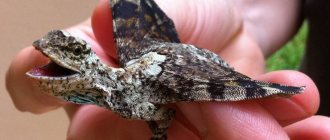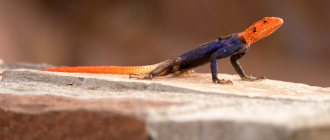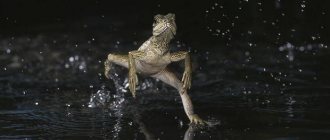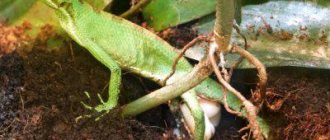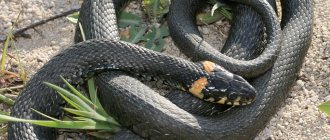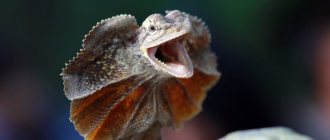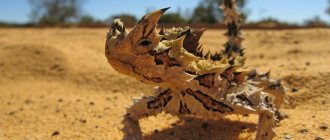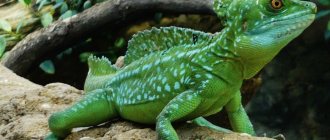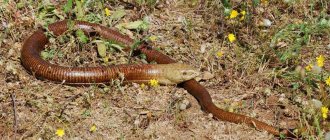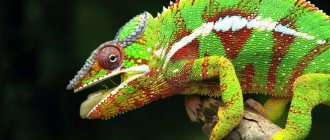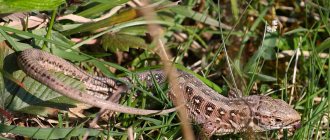Horned (or spiny) devil... this is what the Moloch lizard, which belongs to the agama family, is called in Australia.
Its first description, made in 1841, belongs to researcher John Gray. The animal received its name in honor of a deity named Moloch, one of the characters in pagan mythology. Why did the reptile come to be called the horned devil? Let's take a closer look at this creature, maybe it's his appearance?
Moloch lizard (Moloch horridus).
What does Moloch look like?
At first glance, this animal looks menacing.
The body, the length of which in an adult can reach 20 cm, is quite dense and wide. The head of the moloch is small in size, the muzzle is blunt. The entire body, strewn with short, curved horny spines, is supported by short but strong legs.
The toes have claws.
Moloch's coloration is an excellent camouflage for the Australian deserts.
Above the eyes there are large, frightening-looking growths; the same ones are found on the limbs of the lizard, only in a smaller form.
The back is painted yellow-brown, which is diluted with dark spots. Dark patterned stripes adorn the belly, which has an ocher color.
The spiny devil is a fearsome-looking lizard.
Reproduction of roundheads
Male roundheads are not much different from females; even herpetologists cannot always determine their sex. The most pronounced external difference is the tail of males that is longer and swollen at the base. The sex ratio is approximately equal for all species of roundheads - there is one female for one male. But they do not form permanent pairs.
Courtship games and mating occur in spring and early summer. The female “decides” when and whom to choose as the father of her future offspring. Usually this choice is made simply - the female simply runs away from the gentleman she doesn’t like. Sometimes the latter vigorously pursues her. In such a case, the female has a special form of behavior: turning to the male and tilting her head, she lifts and arches her body. At the same time, she can make lunges towards an unlucky suitor with an agape mouth and even try to bite him. If this does not work, the female uses the last, very effective and unique behavior among lizards: she turns over on her back and remains belly up until the male leaves her alone. If the male is to the female’s liking, then after 2-3 weeks she lays from 1 to 6 eggs. Each female can make two or even three such clutches. The eggs are oblong, covered with a leathery shell. In the second half of summer, babies are born, exact smaller copies of adults, and immediately begin to live independently. Parents do not show any concern for their offspring. The young grow quickly, and some species reach adult size by the beginning of winter.
Security
Due to their biological characteristics, roundheads are completely defenseless creatures; it costs nothing to catch or crush them. When they rest in the upper layer of sand, they are crushed by livestock, vehicles, and also people. Other lizards sitting in burrows are not so easy to crush.
Roundheads are very cute and funny lizards, they are very interesting to watch, but you don't need to catch them to take them home. It is extremely difficult to keep and breed roundheads in captivity; for their comfortable existence it is necessary to recreate a very complex set of conditions. They are completely unsuitable for keeping a home; it is better not to take them to certain death.
Let's follow a simple principle: visit nature and not change anything in it, including not reducing the number of these unique animals by a single individual, and this will be our contribution to their protection.
Literature: The amazing world of reptiles. Semenov D.V. M., 2003; Amphibians and reptiles. Orlova V.F., Semenov D.V. M., 1999.
- Long-eared roundhead
- Squad Squamate
- Where do scorpions live?
- Comb-toed lizards
- Bandicoot…
- Types of chameleons
Horned Devil Lifestyle
This lizard is quite slow, slowly, holding its tail up or straight, it moves through areas with sparse vegetation. She doesn't really have anywhere to hide. Therefore, depending on the light and temperature, the lizard is perfectly camouflaged, almost like a chameleon, changing its color to match the color of the sand.
In warm weather, when they are active, the color of these reptiles is pale yellow or orange, but when they are alarmed or it becomes cool, their skin color becomes dark olive.
To hide from the heat, the moloch digs a hole.
During the day, this reptile is very active. If necessary, it digs a shallow hole and hides in the sand. These lizards live alone, each of them has a small territory of 30 square meters, where they get their food and rest.
What is most striking is that these lizards have a hygroscopic system in the form of grooves in the skin leading to the corners of the animal’s mouth. Water that accumulates during dew or fog moves along the grooves, directly into the moloch’s mouth. This liquid is enough for him to do without a source of water.
In hot weather and winter, he prefers to spend time in his hole.
Lifestyle
In nature, toad lizards like to live in groups. In the cooler period of the year they lead a diurnal lifestyle; in hot summer weather they prefer the evening. The basis of nutrition for these lizards are ants and termites, which is why frynosomes settle near the nests of termites and anthills. Lizards motionlessly guard their food by burying themselves completely in the sand, leaving only their eyes on the surface. They catch their prey with their tongue without chewing.
In winter, toad lizards hibernate. To do this, they burrow into the ground or under tree leaves. On average, hibernation lasts four months. During this time they do not eat and can consume a minimum of water. Before hibernation, they partially store fat, since they can spend up to 10% of their body weight during the winter.
This is the only genus of lizards that produces live offspring. From July to September, from 5 to 50 cubs can appear, the size of which is only 2.5 cm. While the cubs are small, the female carries them on her back.
Eating Moloch
In the wild, the only food for these lizards is ants, which the moloch hunts with its sticky tongue.
From above, the Moloch lizard resembles a cactus.
Finding your own “lunch” is not difficult at all. You just need to find the ant trail, settle down on it and eat in peace. Moreover, in one day, the number of ants eaten by Moloch can reach several thousand units.
Lizard reproduction in nature
A prickly devil in search of an ant trail.
In the spring, when the mating season begins, males go looking for a suitable mate. After fertilization, the female independently looks for a hole, where she lays from 4 to 8 eggs. The female carefully camouflages the nest and covers it with sand. Sometimes this important task takes the Moloch lizard the whole day.
Small lizards will be born in 3.5 - 4 months. Their birth weight is only 2 grams, and their body length is 6 mm.
During the breeding season, the male goes out in search of a female.
The babies' first food will be the shells of their eggs. After some time they will begin to climb to the surface. Since Moloch babies grow very slowly, they will reach their “adult” size only after 5 years, while at the same time their sexual maturity occurs after three years.
The average lifespan of a horned devil is 20 years.
Toad lizards
These small short-legged and short-tailed flat lizards or phrynosomas (lat. Phrynosoma) from the suborder of iguanas have invented a very original way to scare away predators: they shoot their own blood into their eyes, which has irritating properties, because a lot of ant poison accumulates in it.
flickr/Dave Beaudette
But Phrynosomes are not at all bloodthirsty, so they are never the first to go into conflict. When they see the enemy, they first try to freeze and merge with the environment. Fortunately, the coloring allows it - the body color of toad-like lizards depends on the soil. If they are nevertheless noticed, they try to escape, running from one shelter to another.
flickr/bgorum
When the predator gets very close, the phrynosoma swells up, just like a toad, hinting to the toothy one that it is not so easy to swallow (it is because of this property that they began to call it toad-shaped).
flickr/Hot Bologna Pie
And lunch won't be so soft. Still would! Its entire body is covered with very hard scales of varying sizes, and some of them have pointed tubercles. Stripes of triangular teeth run along the sides, the head is protected by long horns, and the tail is protected by sharp outgrowths. Overall, the dish is literally quite spicy.
flickr/randomtruth
And especially persistent or hungry animals run the risk of getting a bloody shower. This is done quite simply: a special muscle contracts and blocks the flow of blood from the head. Due to high blood pressure, blood vessels burst, throwing out a one and a half meter stream of blood. As a rule, the attacker takes some time to figure out what happened, giving the lizard the opportunity to escape.
flickr/Rob Schell Photography
True, not all phrynosomes can boast of this skill. Of the 16 species, only 4 have sniper abilities. The rest have to be content with other tricks. For example, sharply pressing the belly to the ground, not allowing the predator to grab it with the lower jaw. Or sharply push the pointed growths on the head forward, protecting the neck.
flickr/USFWS Mountain Prairie
Toad-like lizards live in the southwestern United States and northern Mexico. They can be found on desert and semi-desert plateaus and plains. The soil should be clay or sandy.
flickr/Todd W Pierson
Some species prefer a height of 3.5 thousand above sea level. It is interesting that during the day it is almost impossible to detect frinosis - they wait out the heat by burying themselves in the sand. Only their favorite treat - ants - can lure them out of hiding. However, they do not mind spiders or other insects.
flickr/bugeyed_G
The breeding season for toad lizards is from April to June. The female lays about 37 eggs, from which three-centimeter lizards emerge within a month. The kids are quite independent; they quickly bury themselves in the sand for fear of being eaten. Phrynosomes live for about 5 years.
Who is Moloch's enemy?
Despite their seemingly terrifying appearance and excellent camouflage, these reptiles very often become prey for birds, snakes and monitor lizards.
A frightening appearance does not always protect a moloch from enemies.
His only defense is the thorns and growths that he exposes by lowering his head down. In addition, the moloch, inhaling a large amount of air, increases the size of its body. Someone will probably be frightened by the appearance of the lizard and will not mess with it, but there are also predators who do not care what their future lunch or dinner looks like.
Today this species of animal is on the verge of extinction. To preserve the moloch, Australian zoologists place a fence made of wire around the lizards' nests. Such actions make it possible to provide protection for newborn, helpless devils for some time. Statistics show that this method gives positive results.
If you find an error, please select a piece of text and press Ctrl+Enter.
The mystery of the name
It was mentioned above that due to the extensive arrangement of spines on the body and head of the reptile, it received the nickname horned, but in scientific materials such an iguana is called toad-shaped (from the Latin word Phrynosoma). This is because her body is flat and round, and her legs are short. She looks a lot like a toad. Phrynos translates to "toad" and soma means "body". The color of the horned lizard is as close as possible to the colors of the environment in which it lives. Most often it is the color of earth or sand, or both colors mixed.
But these are not all the secrets that the horned lizard hides. The name bloody is also quite suitable for her. This is because she has one unique ability to scare off her opponents with her own blood. And she shoots it out of her eyes. Such a phenomenal ability can easily scare off the horned lizard's ground opponents, but the birds are not at all afraid of this method of intimidation.
